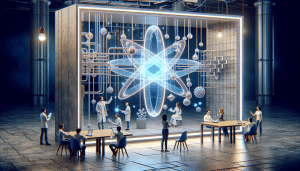Unlocking Artificial Intelligence in Everyday Life
Aiden Foster September 24, 2025
Artificial intelligence is powering devices and shaping the way people live, work, and communicate. Learn how AI, machine learning, and automation impact your daily experiences, discover surprising uses in tech and science, and explore considerations around privacy, ethics, and the future.
AI Integration in Daily Technologies
Artificial intelligence, often called AI, has seamlessly blended into people’s routines, transforming everything from smartphones to transportation. Devices now anticipate needs, recommending content or responding to voice commands, thanks to embedded machine learning algorithms. The impact is subtle but powerful. Think of navigation apps rerouting during traffic jams or personal assistants that schedule meetings and answer queries. These advancements come from a fusion of AI concepts, including neural networks and deep learning models, that allow technologies to learn from user behaviors and historical data.
The experience of interacting with digital platforms has evolved rapidly. Search engines rank results based on sophisticated algorithms, trying to understand intent rather than merely matching keywords. In smart homes, lighting, heating, and even refrigerators utilize artificial intelligence to optimize energy use and improve comfort. Devices adjust automatically to preferences, learning more with each interaction. This trend demonstrates how closely AI and automation are tied to lifestyle improvements, making it a significant focus for tech giants and startups alike.
Behind the scenes, advances in AI have influenced fields such as healthcare, financial trading, and disaster response. In healthcare, AI tools analyze medical images, flagging abnormalities and assisting professionals in diagnosis. Banks deploy automated systems for fraud detection, while data scientists leverage massive datasets for predictive analytics. Even entertainment platforms—like streaming services—use recommendation engines rooted in AI principles. These everyday integrations are just the surface of a broad and rapidly advancing technological landscape.
Machine Learning Unveiled: How Computers Learn
Machine learning is a branch of artificial intelligence that gives computer systems the ability to improve at tasks through experience, rather than explicit programming. At its core, machine learning relies on exposing algorithms to large datasets, allowing them to identify patterns, correlations, and trends. This enables everything from speech recognition to image classification with surprising accuracy. The process is not magic, but a methodical combination of mathematics, statistics, and computational power.
Supervised learning, where models are trained using labeled data, and unsupervised learning, which finds structure in unlabeled data, are among the core methods. Reinforcement learning goes a step further, rewarding or penalizing algorithms as they take actions, mimicking human trial and error. Examples include self-improving gaming bots and automated trading programs. These approaches allow systems to adapt and perform complex tasks across industries. The pace of progress continues to accelerate, fueling excitement among researchers and practitioners alike.
Real-world applications flourish as a result of these machine learning breakthroughs. Voice assistants get better with each user query. Robots in manufacturing lines adjust to variables in production. In cybersecurity, adaptive systems detect anomalies and protect data. The keyphrase ‘machine learning’ often appears in news about innovation, underscoring its central role. Every area touched by AI, from transportation to customer service, benefits from its ability to constantly evolve and optimize solutions to real-world problems.
The Rise of Automation: Opportunities and Challenges
Automation harnesses AI and robotics to perform repetitive, dangerous, or labor-intensive tasks without human intervention. Industries such as manufacturing and logistics have seen immense changes with robotic arms, supply chain algorithms, and automated sorting systems. These methods enhance safety, boost efficiency, and cut costs. Advanced sensors and AI-based control systems let machines respond to complex variables, adapting to changes in real time. Automation will only expand its reach as technology matures and becomes more accessible.
The benefits of automation are clear: streamlined operations, increased productivity, and a reduction in human error. But challenges persist. Concerns about the future of work arise as automation replaces some routine jobs. Organizations must develop new strategies for workforce transition, focusing on skills that complement technological tools. Automation is not only about robots on assembly lines; it includes software bots handling administrative tasks, virtual agents assisting customers, and smart platforms simplifying data entry.
The implications for society are profound. Research suggests that as automation becomes more widespread, new job categories will emerge, demanding higher-level cognitive or creative skills. The collaboration between humans and intelligent machines could unlock productivity not yet imagined. Continuous learning—both for people and AI—remains crucial as change accelerates. Both opportunity and responsibility accompany the march toward a more automated world.
Everyday Science: AI in Healthcare, Environment, and Beyond
Many breakthroughs in science and healthcare leverage artificial intelligence to process data on an unprecedented scale. In medicine, AI assists with diagnostics, drug discovery, and personalized treatments, yielding more accurate and faster results. Tools that interpret X-rays, MRIs, or genetic information now draw on massive databases, identifying disease trends humans might miss. This integration of human expertise with AI-driven analysis fuels a wave of innovation benefiting patients and medical professionals alike.
The environment is another arena transformed by machine learning and automation. Smart sensors in agriculture help optimize water usage, detect crop diseases, and increase food supply sustainability. Researchers use autonomous drones and data analytics to monitor ecosystems and wildlife populations. Predictive weather models, powered by AI, give earlier warnings about storms and natural disasters. These implementations demonstrate the positive impact technology can have on global environmental challenges.
Other scientific fields, from astronomy to genomics, use advanced computing power and machine learning algorithms to sift through enormous datasets. AI-driven telescopes identify celestial bodies faster than ever before. Genomics projects make use of pattern recognition to discover gene links. These developments wouldn’t be possible without the ability of computers to learn, adapt, and generate predictions. As access grows, the potential for AI applications in everyday science only increases, inviting new collaborations and discoveries.
Privacy, Ethics, and Trust in the AI Era
Rapid adoption of artificial intelligence comes with important discussions about privacy, ethics, and trust. Data collection fuels many AI-powered tools, yet users are increasingly aware of how their personal information is handled. Automated systems, if not carefully managed, pose risks for bias, discrimination, or unintentional consequences. This reality has pushed governments, researchers, and technology companies to create ethical guidelines and transparent development processes.
Balancing innovation with responsibility requires thoughtful governance structures. Some organizations invest in developing explainable AI—systems that make their decision-making transparent and understandable. Ethics boards review new projects, examining potential risks and benefits. Data privacy regulations, such as those found in Europe and other regions, aim to safeguard users’ rights while still enabling progress. Striking the right balance is a work in progress, constantly adapting to the fast-changing landscape.
Building trust in AI-powered systems takes time. Users need assurance that their data is secure and that algorithms remain fair. Collaborative approaches—combining input from technologists, ethicists, community groups, and policymakers—yield more balanced solutions. With clear communication and ongoing review, the possibilities of artificial intelligence can be explored responsibly, benefiting all stakeholders while minimizing risks.
The Future of Artificial Intelligence: What Lies Ahead
Artificial intelligence continues to evolve at an astounding pace, unlocking new opportunities and posing fresh challenges. Advances in quantum computing, for instance, may further boost the capabilities of AI, speeding up analysis and broadening its application. Many experts predict that the line between human and machine will keep blurring as interfaces improve and AI becomes more intuitive. The dialogue between science and society shapes what comes next.
Education and lifelong learning will be essential to thrive in this environment. People must adapt to collaborate with AI tools and understand their strengths and limits. Creativity, critical thinking, and emotional intelligence remain vital—skills that complement the technical solutions offered by AI and automation. The future may include personalized education paths, AI-driven healthcare solutions, and smarter cities, all backed by research and scientific advances.
Staying informed is the key to leveraging artificial intelligence for personal and professional benefit. As applications expand, familiarity with terms like ‘machine learning,’ ‘automation,’ and ‘data ethics’ will be increasingly valuable. The conversation around AI belongs to everyone—researchers, businesses, policymakers, and everyday users. With thoughtful exploration and engagement, artificial intelligence can help create a more connected, innovative, and inclusive future.
References
1. National Institute of Standards and Technology. (n.d.). Artificial Intelligence. Retrieved from https://www.nist.gov/artificial-intelligence
2. Stanford University. (n.d.). AI Index Report. Retrieved from https://aiindex.stanford.edu/report/
3. World Health Organization. (n.d.). Ethics and governance of artificial intelligence for health. Retrieved from https://www.who.int/publications/i/item/9789240029200
4. European Commission. (n.d.). Ethics guidelines for trustworthy AI. Retrieved from https://ec.europa.eu/digital-strategy/our-policies/european-approach-artificial-intelligence
5. MIT Computer Science & Artificial Intelligence Lab. (n.d.). Machine Learning. Retrieved from https://www.csail.mit.edu/research/machine-learning
6. United Nations Environment Programme. (n.d.). Artificial Intelligence and the Environment. Retrieved from https://www.unep.org/resources/report/artificial-intelligence-and-environment








